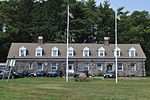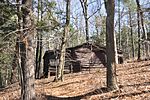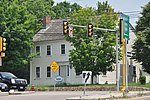Refreshment Pavilion
Buildings and structures completed in 1920Buildings and structures in Norfolk County, MassachusettsMilton, MassachusettsNational Register of Historic Places in Milton, MassachusettsRestaurants established in 1920 ... and 3 more
Restaurants in MassachusettsRestaurants on the National Register of Historic Places in MassachusettsUse mdy dates from April 2019

The Refreshment Pavilion is a historic refreshment stand at Houghton's Pond in the Milton portion of Blue Hills Reservation, a Massachusetts state park. Built in 1920, it is one of a series of architect-designed structures built in the park by the Metropolitan District Commission. It was listed on the National Register of Historic Places in 1980.
Excerpt from the Wikipedia article Refreshment Pavilion (License: CC BY-SA 3.0, Authors, Images).Refreshment Pavilion
Hillside Street,
Geographical coordinates (GPS) Address Nearby Places Show on map
Geographical coordinates (GPS)
| Latitude | Longitude |
|---|---|
| N 42.20875 ° | E -71.097361111111 ° |
Address
Hillside Street 848
02186
Massachusetts, United States
Open on Google Maps










